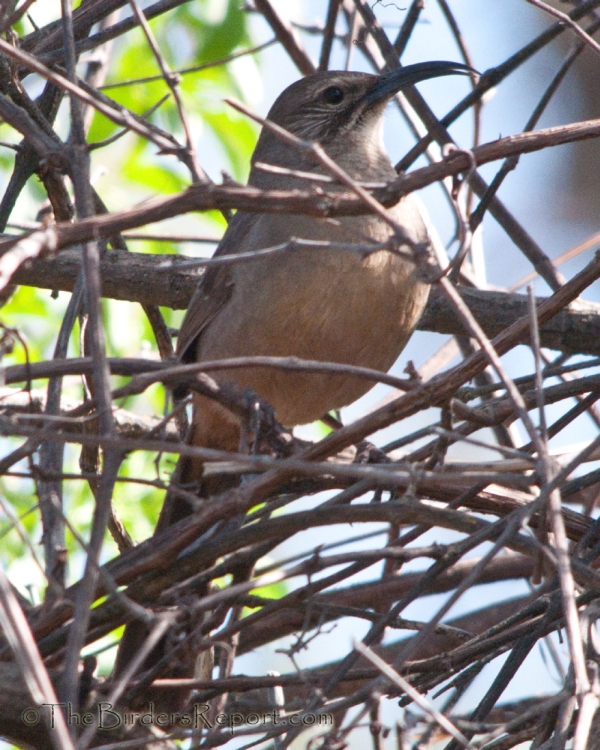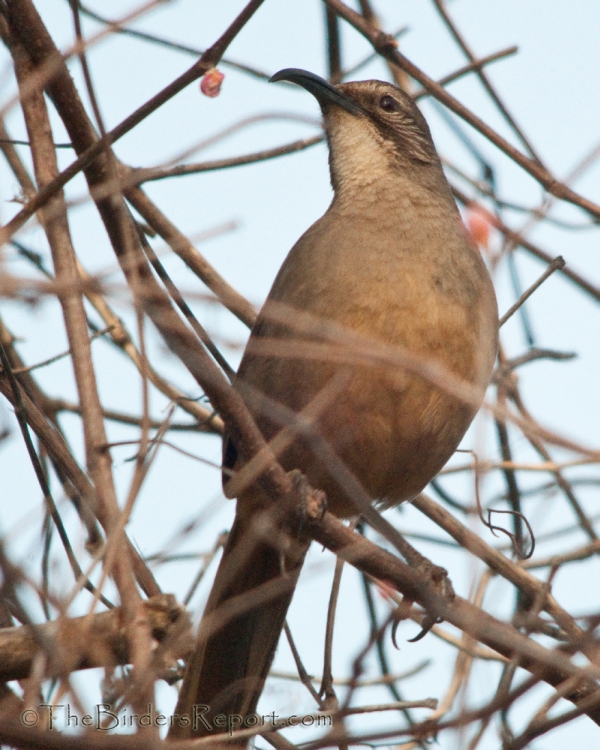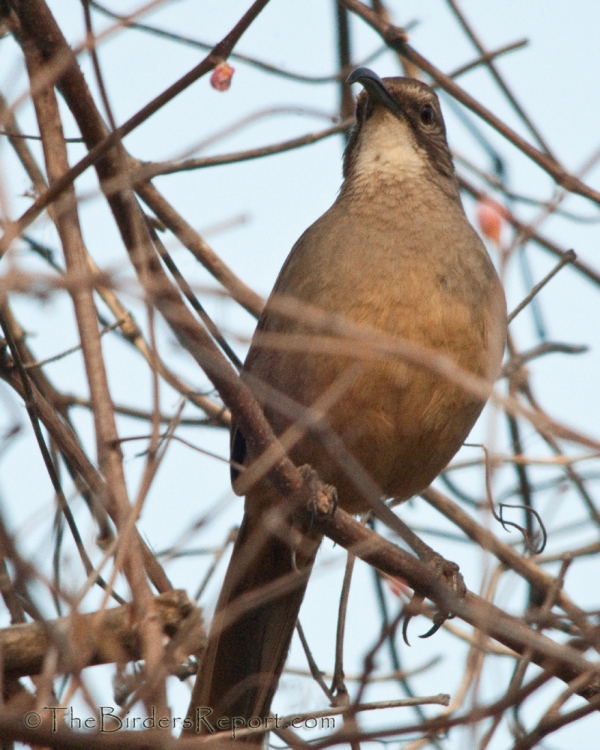The California Thrasher (Toxostoma redivivum) is endemic to coastal and foothill areas of California, extending into adjacent areas of northwest Baja California. Yup, another California native and a sweet songster to boot! You can hear one of their varied songs here (Courtesy of Xeno-canto, recorded by Steve Hampton, file XC70739).

I found this beauty hiking a not well known area next to the Sacramento River called Reading Island. It’s a small sliver of land with the river on one side and an inlet on the other. The local list serve, Shasta Birders, posted a sighting of California Thrashers so I thought I’d see what I could find.
Just when I was about to give up, I heard that sweet song coming from the brush nearby. This bird flew up into pretty heavy cover as you can see in the first photo, but eventually came up into the light for a few quick shots.
As you can see, they are a very handsome bird with that long, sickle-shaped bill. If you haven’t seen this bird yet, I hope you get the chance someday. They are not only a joy to listen to, they are fun to watch too!













Several of these songsters were seen this morning on the regular Wednesday birdwalk at Big Morongo Canyon Preserve in Morongo Valley, a tad north of Palm Springs CA.
Great bird, and nice photos… I hope to see it in the future!
Awesome shots of an impressive bird! I still need it!
That’s one big Beauty, Larry!
I have had what I just learned is a Thrasher in my yard for a few months now. The reason I couldn’t identify him is because he has a very long, curved beak – about 2 1/2 times the length of his head! It’s evidently deformed. One leg has a lot of over growth – it looks like dried mud all over it. He tucks this leg up whenever he’s not hobbling around.
I feed him dry cat food and peanuts which he looks forward to but eats with what looks like difficulty out of the side of his beak.
There are not any wild bird rescuers available; the Wildlife Rescue Station is over-taxed. I wonder what I can – or if I should – do something for him. He looks chubby and otherwise healthy.
@Christine if you watch birds for a long time, you will eventually see some with deformities. More probably around homes with feeders than out in nature.
My philosophy is that these birds have made it through their lives without our help for the most part, and will keep doing whatever it is that got them to where they are now until there lives are over. In nature it is survival of the fittest. If a predator grabs a bird because it is slower than the others or sick because it can’t eat, it keeps that bird from breeding and possibly passing its genes on to another generation.
I totally support wildlife rescue and rehabilitation and contribute to several organizations but these animal’s injuries are usually caused by humans in some way or another and therefore it is our duty to try to make them whole again.
In the case of a deformed bird or other animal, I believe they need to make it on their own, without intervention. Nature has her own way of dealing with these situations and she is much wiser than we mere mortals.
Thanks, Larry. I agree completely; it’s just hard to know sometimes if one is ignoring a helpless animal in need or if you’re messing with Mother Nature!
BTW: What sort of human intervention can cause deformities in birds? I want to be sure I don’t do that!
I believe that I have a olive-greenidh-gray thrasher with a dark brown or black downward curved beek. He really likes my homemade hummingbird juice. I’m not sure how to upload a picture but I will as soon as I can figure how to do it.
My thresher, Beaky, hasn’t been seen in over a week. He was in my yard constantly for months, waiting for the peanuts I gave him about a thousand times a day. He was looking really good (aside from the one leg and that enormous beak!) so I don’t know what to think. I’ve searched under the bushes and everywhere in case a cat got him, but no sign of him. I really miss him!
Do you know if their beaks continue to grow? After the Thomas fire where my business was almost completely surrounded by the fire we were inundated with wildlife. We put out a water trough and a small fountain and the birds literally lined up to drink. So I bought bird seed as well. Before the fire there was a California Thrasher that would stop on my window sill and peck at the window near a shiny bell inside. I moved the bell closer to the glass and he would look at himself. A few days after the smoke cleared, he reappeared for some bird seed and a look at himself. Since then I get a ton of them stopping by. Some have much longer beaks but the all seem to have that curve. I’m wondering if the longer beaked ones are males, or maybe more mature?
Tamar I have a couple of thoughts for you. According to The Sibley Guide to Bird Life & Behavior, regarding thrashers, “juveniles of most species have shorter, straighter bills, as compared to adults.” Also, in your area, you may also have the Le Conte’s Thrasher visiting your yard, especially if they were displaced by the fire. The Le Conte’s Thrasher has a shorter curved bill but is also much lighter in color.